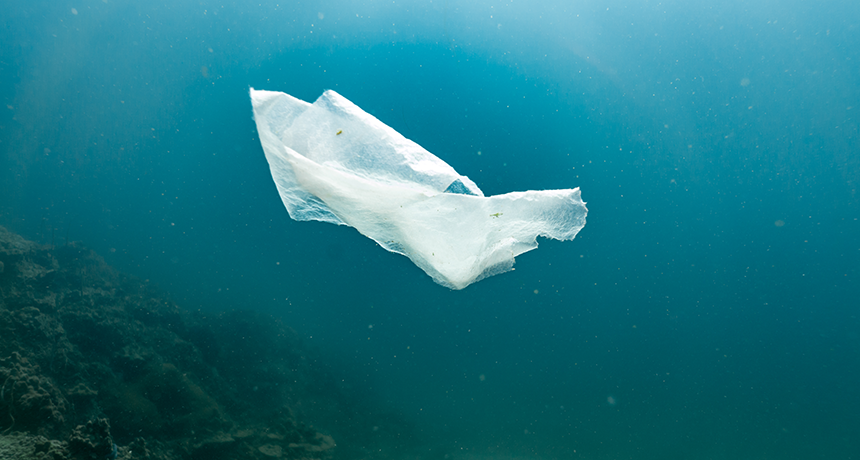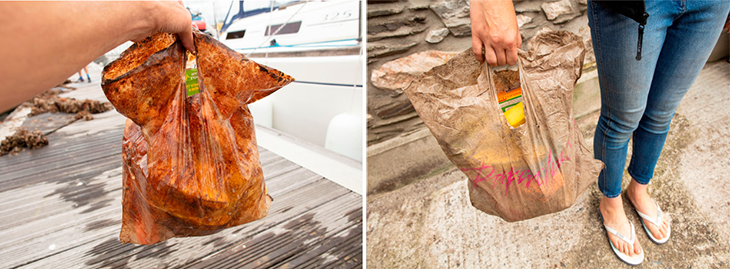‘Biodegradable’ plastic bags often don’t break down
Some 'green' plastics could still hold five pounds of groceries after three years outside

Biodegradable plastic bags could help reduce plastic pollution in the environment — but only if the material actually breaks down. Most don’t.
Placebo365/iStock/Getty Images Plus
Plastic bags are handy for carrying light items. But many are trashed after a single use. Some of these bags end up as litter that may harm animals (including those in the ocean). That’s one reason some companies have switched to biodegradable plastic. These are supposed to break down faster than regular plastics. But a new study in England shows that may not happen.
“Single-use plastic bags are a huge source of litter worldwide. We wanted to test whether biodegradable plastic bags could help reduce plastic pollution,” says Richard Thompson. He’s a marine biologist at the University of Plymouth in England. Thompson and a graduate student, Imogen Napper, decided to test that.
Materials break down through rot or decay. That’s usually a process whereby microbes feed on them, breaking big molecules into smaller, simpler ones (such as carbon dioxide and water). Other living things can now feed on these breakdown products to grow.
The problem: Ordinary plastic bags are made from oil, which few microbes can digest. So these plastics don’t decay easily.
Biodegradable plastics are sometimes made from materials that microbes do readily digest. Others may be held together with chemical bonds that break apart when exposed to water or sunlight. There’s also no one rule for how quickly biodegradable plastic bags should break down. Some plastics may even need special conditions — such as heat — to fully break down.
To study how well these bags live up to such claims, Thompson and Napper collected 80 single-use plastic bags from stores for testing.
Watching and waiting
The pair chose bags made from each of four different types of biodegradable plastic. They would compare these to a group of ordinary plastic bags. For the tests, they submerged some bags of each type in ocean water. They buried some of each type in garden soil. They tied others to a wall where the bags could flutter in the breeze. They placed still more of them in a closed, dark box in the laboratory.
Then the scientists waited. For three long years they observed what happened to these bags. At the end, they measured how well the plastic had broken down.
Most of the bags didn’t break down much in soil or seawater. Even after three years in such environments, three of the four types of biodegradable bags could still hold up to 2.25 kilograms (5 pounds) of groceries. The ordinary plastic bags could too. Bags marked “compostable” were the only ones that disappeared completely.

In the open air, the results were different. Within 9 months, all the types of bags began to break apart into tiny pieces.
But this is different from decay. Exposure to sun, water or air can help break chemical bonds that hold plastic molecules together. It does not, however, break big molecules into simpler ones. It just makes smaller and smaller bits of the starting plastic. “The object may disappear, but the material doesn’t,” says biochemist Taylor Weiss. He works at Arizona State University in Mesa. Although not involved in this study, he does work on biodegradable plastics.
This breaking of plastic into smaller fragments may be a good starting point, he says. It may make the plastic easier for microbes to digest. But any chunks not eaten can further break apart into microplastics. These bits — each smaller than a rice grain — can spread easily through the environment. Some travel long distances in the air. Others end up in the ocean. Animals even mistake these tiny pieces for food.
Chemist Marty Mulvihill says he’s “a little surprised” that most of the bags could still hold groceries after three years. But he’s not surprised the bags didn’t decay completely. He’s a co-founder of Safer Made, a California company that aims to create products that are safer for people and the environment.
Different environments contain different types and numbers of microbes. Their physical conditions differ too. There’s less sunlight and oxygen underground, for instance. Such factors can affect how fast something decays, explains Mulvihill.
Overall, none of the types of plastic bags consistently broke down in all the environments, the researchers concluded. They shared their findings May 7 in Environmental Science & Technology.
Concludes Mulvihill, “Just because something says ‘biodegradable’ doesn’t mean you should litter it.”
Reduce and reuse
If biodegradable plastic bags aren’t actually breaking down in the environment, what should people do?
“Use fewer bags,” says Thompson. Reuse clean plastic bags more than once before throwing them out. Or take reusable bags with you when you go shopping, he suggests.
People have been carrying things around for thousands of years. Single-use plastic bags only became common in the 1970s. “We’ve become conditioned to expect the convenience everywhere we go,” he says. However, he adds, “That’s a behavior we need to reverse.”







